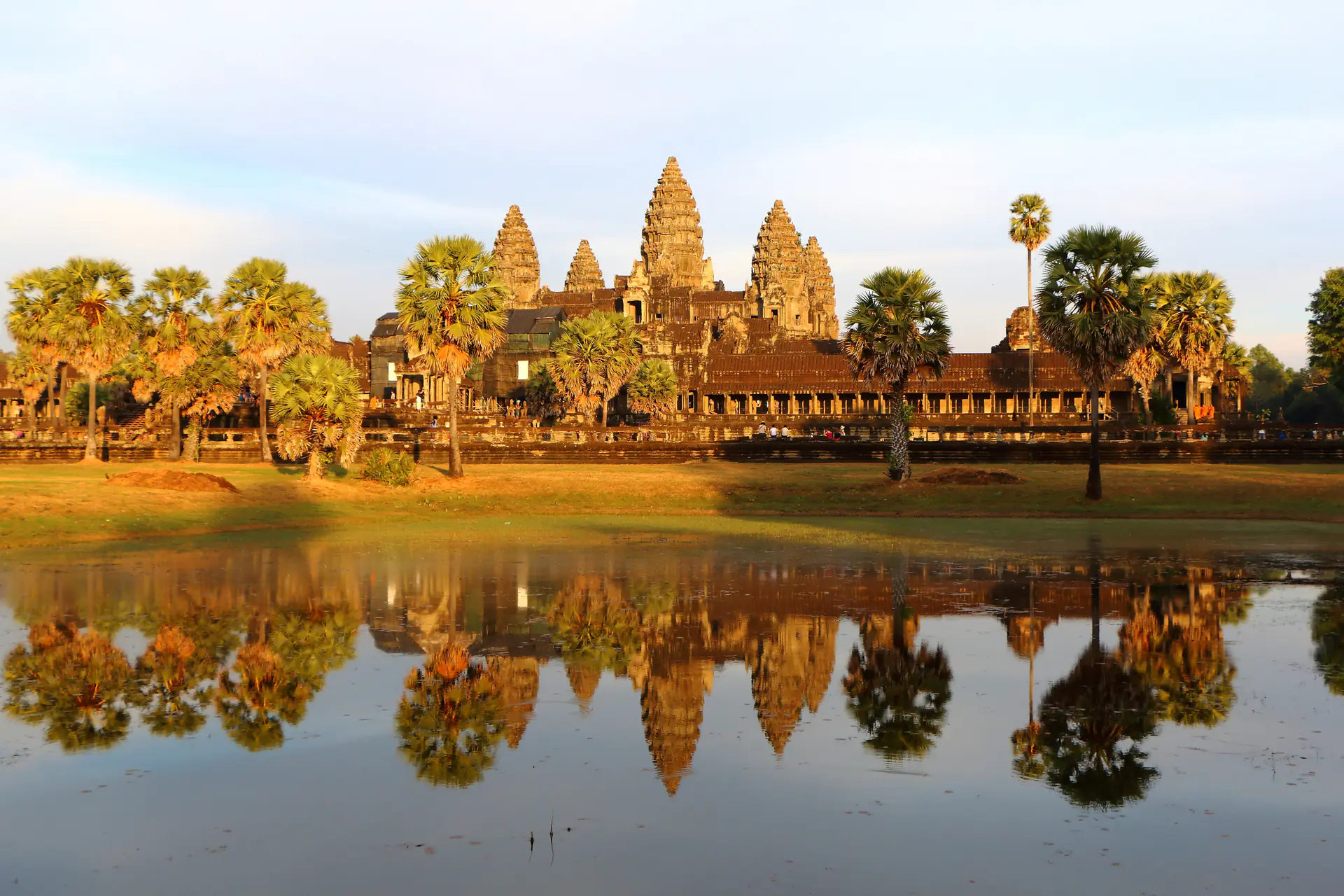
Angkor Wat and the Magnificent Khmer Temple Empire
Monument to Southeast Asian Architectural Mastery
About This Site
Angkor represents the most magnificent expression of Khmer civilisation, showcasing extraordinary architectural achievement across over 400 square kilometres of ancient temples, hydraulic systems, and urban planning. This UNESCO Cultural Heritage site contains Angkor Wat, the largest religious monument in the world, alongside hundreds of temples demonstrating sophisticated artistic and engineering capabilities that sustained Southeast Asia's most powerful medieval empire. The extensive bas-reliefs depict Hindu epics and historical battles in stunning detail, whilst innovative water management systems enabled a thriving metropolis supporting over one million inhabitants. The site preserves exceptional testimony to Khmer culture through intricate stone carving, astronomical alignments, and monumental architecture that continues inspiring wonder today.
Why It Matters
This exceptional cultural site demonstrates outstanding universal value as a masterpiece of human creative genius, providing testimony to the Khmer civilisation whilst representing an outstanding example of architectural and artistic achievement that illustrates significant stages in human history through its innovative urban planning and hydraulic engineering.
Treasures of the Khmer Empire
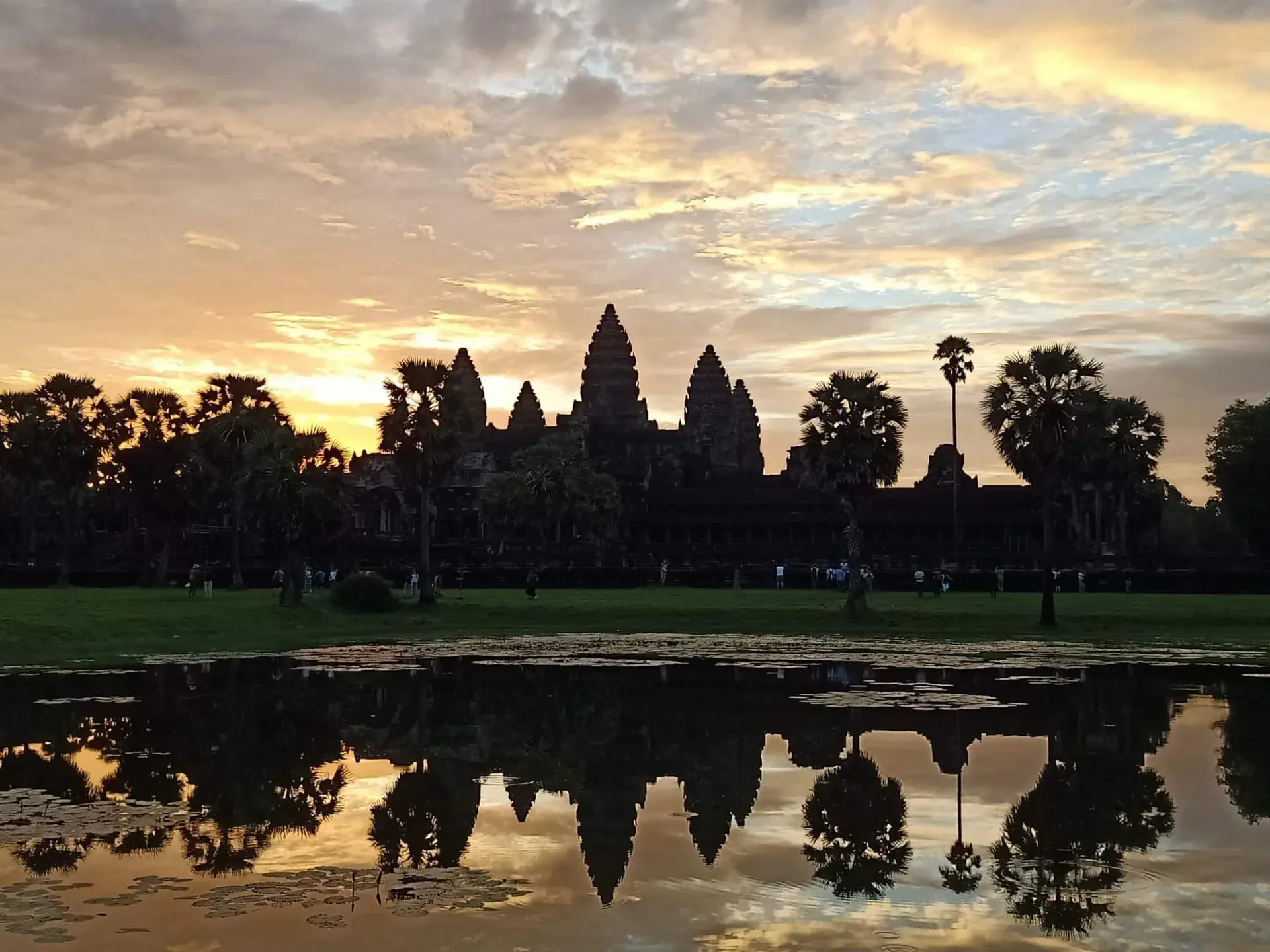
Angkor Wat at Sunrise
Experience the iconic sunrise over Angkor Wat as the five distinctive towers emerge from darkness, reflected perfectly in the surrounding moat. This UNESCO World Heritage site reveals its full architectural majesty during golden hour when soft light illuminates intricate bas-reliefs depicting Hindu mythology. The temple represents Mount Meru, home of the gods, with its quintet of towers symbolising the mountain's five peaks. Built by King Suryavarman II in the early 12th century, this magnificent structure originally served as a Hindu temple dedicated to Vishnu before transforming into a Buddhist shrine. The scale is breathtaking—covering 162.6 hectares with 800-metre galleries adorned with Southeast Asia's finest stone carving. Early morning visits offer cooler temperatures and optimal photography conditions.
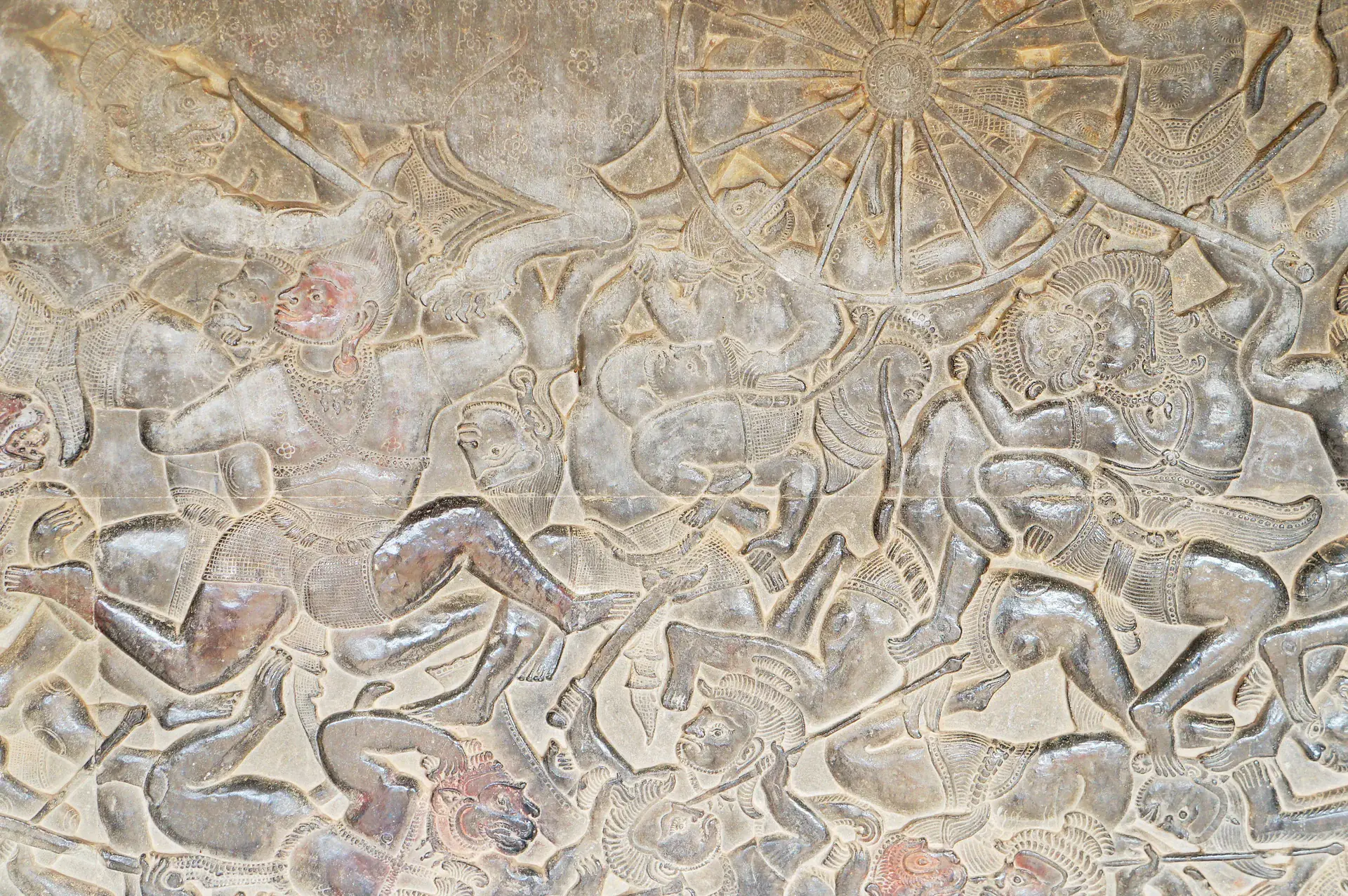
Bas-Relief Battle Scenes
Marvel at the extraordinary 800-metre bas-relief galleries encircling Angkor Wat that depict epic battles, Hindu creation myths, and historical events in stunning detail. The most famous panel illustrates the Churning of the Ocean of Milk, showing 88 asuras (demons) and 92 devas (gods) pulling the serpent Vasuki to churn the cosmic ocean and extract immortality's elixir. Each figure displays unique facial expressions and costumes, demonstrating sophisticated artistic capabilities of 12th-century Khmer sculptors. Other panels depict the Battle of Kurukshetra and King Suryavarman II's military campaigns, providing invaluable historical records alongside mythological narratives. The carving technique achieves remarkable depth through subtle relief height variations.
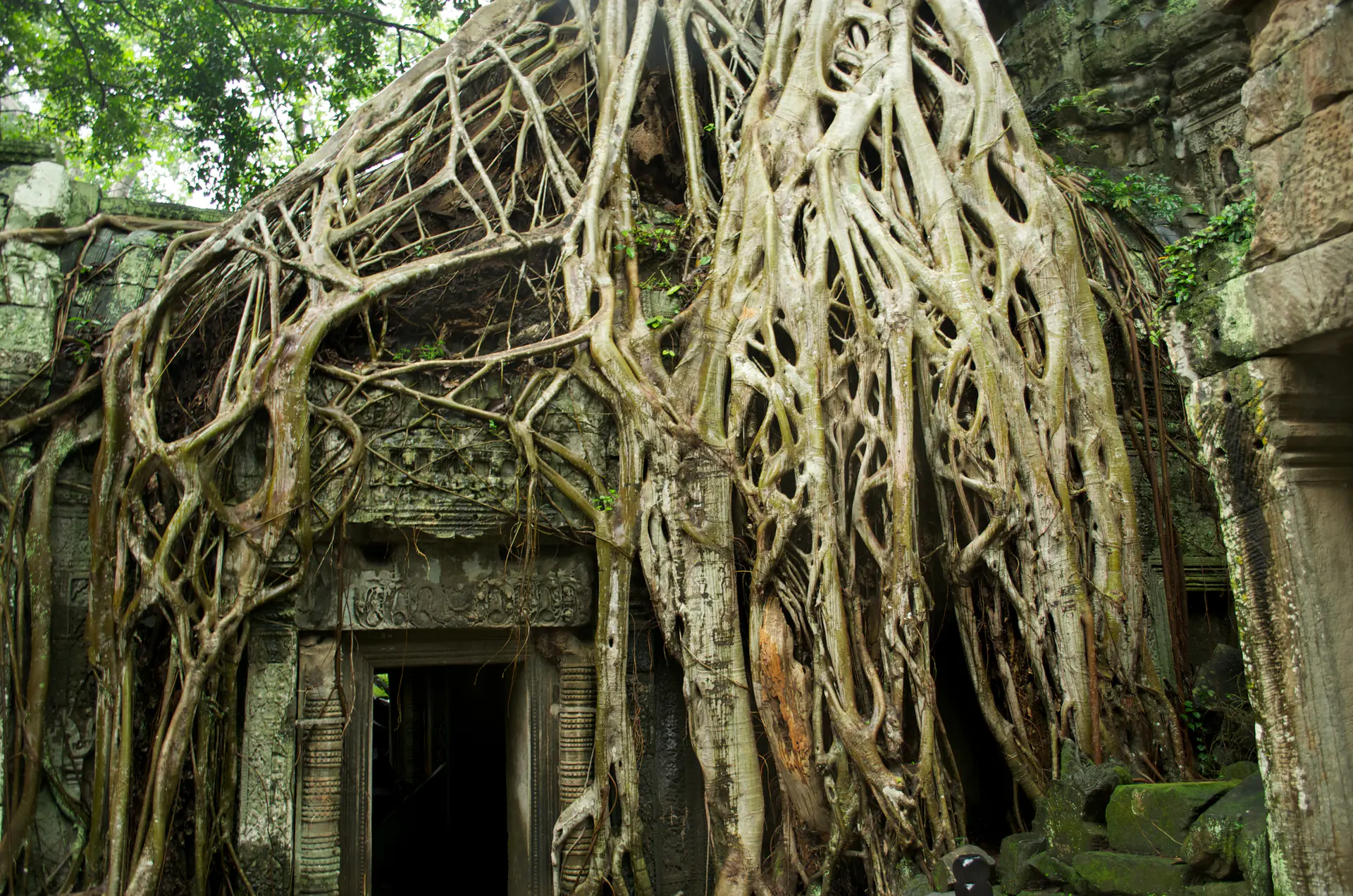
Ta Prohm: Nature Reclaiming Architecture
Explore the atmospheric Ta Prohm temple where massive silk-cotton trees and strangler figs grow through ancient stone galleries, creating one of Angkor's most photographed sites. Unlike extensively restored temples, Ta Prohm remains largely as French explorers discovered it in the 19th century, with enormous tree roots cascading over doorways and walls. Built as a Buddhist monastery and university in the late 12th century, the complex once housed 2,740 monks and 615 dancers. The preservation of this jungle-engulfed state demonstrates the powerful relationship between nature and architecture whilst creating an evocative atmosphere. The interplay between organic and constructed forms reveals both the impermanence of human creations and nature's enduring power.
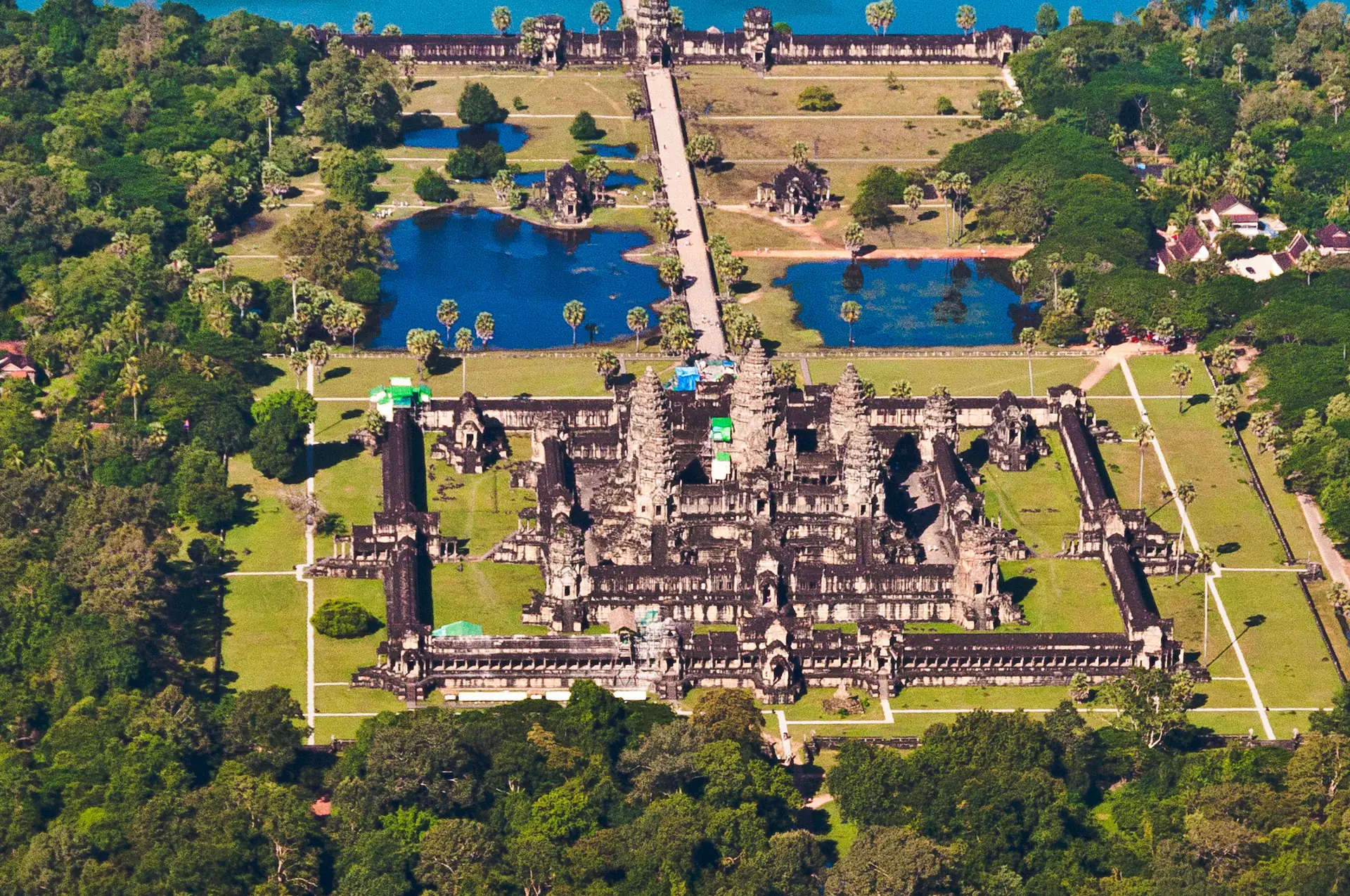
Bayon Temple and the Faces of Avalokiteshvara
Visit the enigmatic Bayon temple at the heart of Angkor Thom, where 216 serene stone faces gaze outward from 54 towers, creating one of the ancient world's most distinctive monuments. Built in the late 12th century by King Jayavarman VII as his capital's centrepiece, the faces likely represent the bodhisattva Avalokiteshvara, embodying compassionate Buddhist philosophy. The temple's unique design features three levels, with bas-relief galleries depicting historical events and daily life in 12th-century Cambodia. The central sanctuary rises 43 metres, with massive stone faces watching over all cardinal directions. The temple's symbolism reflects the transition from Hinduism to Mahayana Buddhism characterising Jayavarman VII's reign.
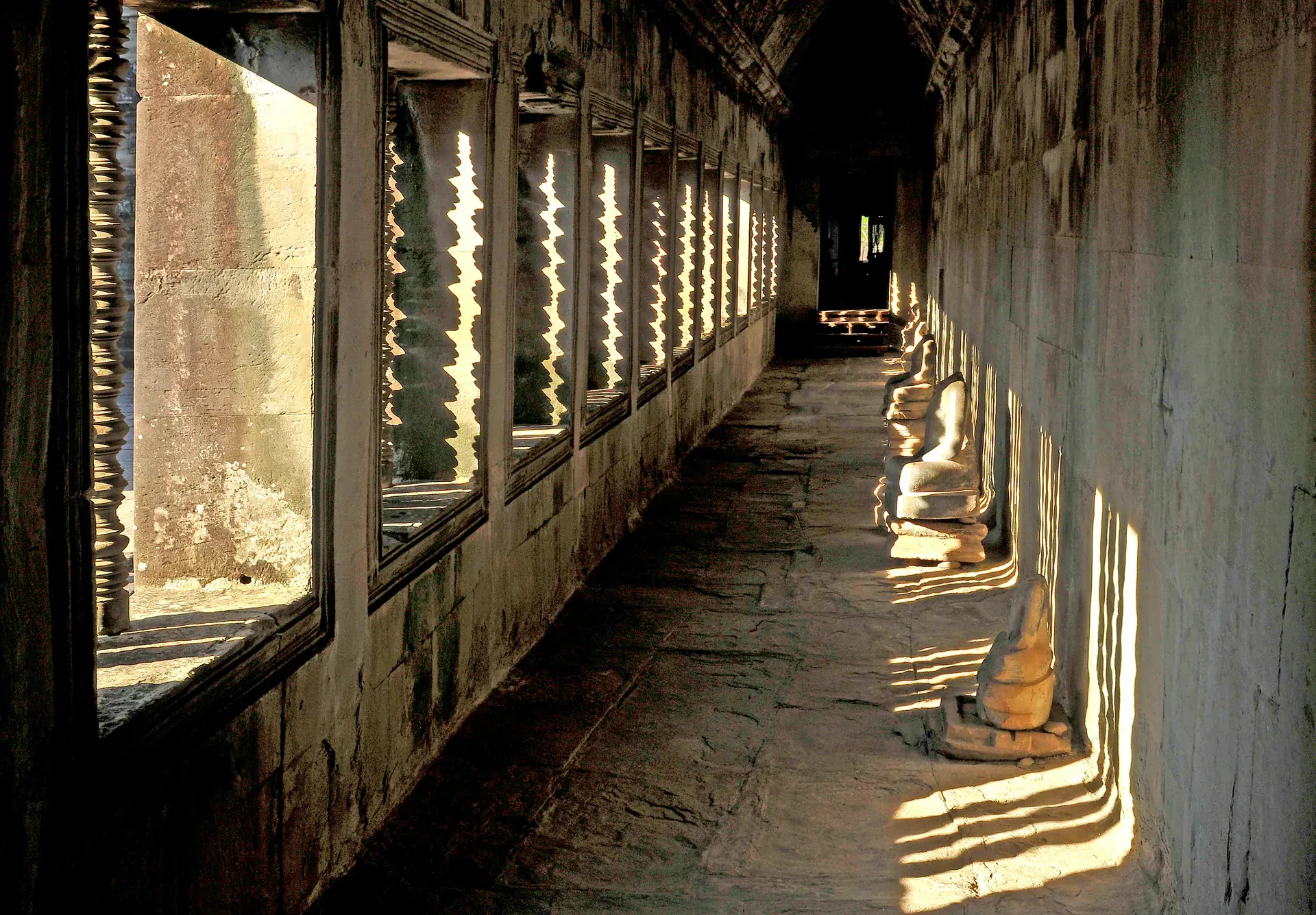
Ancient Gallery Architecture
Walk through covered galleries to appreciate sophisticated architectural techniques creating vast interior spaces using corbel arch construction. The galleries served multiple purposes: providing shaded processional pathways for religious ceremonies, displaying extensive bas-relief narratives, and creating dramatic transitions between courtyards and sanctuaries. The repetitive rhythm of columns and doorways creates striking visual perspectives that draw visitors deeper into temple complexes. Stone lintels above doorways feature intricate carvings of deities and mythological scenes, with each doorway carefully oriented according to astronomical and cosmological principles. The galleries demonstrate advanced structural engineering, with stone blocks precisely fitted without mortar to support substantial weight loads whilst allowing for seasonal expansion in tropical climate.
Location & Planning
Siem Reap serves as gateway, 6 kilometres from Angkor Wat. Hire tuk-tuks for flexible temple exploration or rent bicycles. Purchase multi-day passes at ticket office. Bring passport photo. Hotels and restaurants abundant in Siem Reap town centre.
Loading map...
Frequently Asked Questions
Angkor Wat is the largest religious monument in the world, built in the 12th century as the Khmer Empire capital's centrepiece. Famous for its five-tower silhouette, extensive 520-metre bas-relief galleries, and sophisticated architectural design representing Hindu cosmology through stone.
King Suryavarman II commissioned Angkor Wat between 1113-1150 CE as his state temple and mausoleum. Skilled Khmer artisans transported 5-6 million tonnes of sandstone blocks from quarries 50 kilometres away, creating architectural masterpieces through precise stone carving without mortar.
Siem Reap serves as the gateway, located just 6 kilometres from Angkor Wat. Hire tuk-tuks for flexible temple circuit exploration or rent bicycles for closer temples. Purchase multi-day passes at the ticket office near the entrance for comprehensive access.
November through February offers coolest temperatures and minimal rainfall for comfortable temple exploration. Sunrise visits (05:30-07:00) provide spectacular lighting conditions, fewer crowds, and optimal photography opportunities with temple reflections in surrounding moats creating iconic images.
Entry requires Angkor Archaeological Park passes: 1-day (37 USD), 3-day (62 USD), or 7-day (72 USD) options available. Purchase online or at ticket office with passport photo. Photography included except for commercial filming requiring separate authorisation.
Wear lightweight, breathable clothing covering shoulders and knees for temple entry requirements and sun protection. Comfortable walking shoes with good grip essential for climbing steep stairs and navigating uneven stone platforms throughout extensive temple complexes.
Unlike most Khmer temples facing east, Angkor Wat faces west towards the setting sun, traditionally associated with death in Hindu cosmology. This unique orientation suggests the temple served as King Suryavarman II's funerary temple and mausoleum.
UNESCO World Heritage Criteria
Inscribed in 1992, this site meets 4 of UNESCO's 10 criteria for Outstanding Universal Value
Criterion (i): Masterpiece of human creative genius
Angkor Wat represents an absolute masterpiece of creative genius through its unprecedented scale, mathematical precision in cosmological symbolism, extraordinary bas-relief galleries depicting epic narratives spanning 800 metres, and revolutionary architectural innovations including corbelled arches and complex hydraulic engineering systems.
Criterion (ii): Interchange of human values
The Angkor monuments facilitated exceptional interchange of human values across Southeast Asia, spreading Khmer architectural principles, Hindu-Buddhist religious concepts, and sophisticated urban planning innovations throughout mainland Southeast Asia whilst absorbing influences from India and China.
Criterion (iii): Testimony to cultural tradition
Angkor provides unique testimony to the Khmer Empire at its zenith, representing one of history's most sophisticated pre-industrial civilisations through monumental religious architecture, advanced hydraulic infrastructure, and urban planning demonstrating exceptional administrative and engineering capabilities sustaining over one million inhabitants.
Criterion (iv): Outstanding architectural/technological ensemble
Angkor Wat exemplifies outstanding architectural achievement through its perfectly proportioned five-tower design representing Mount Meru cosmology, innovative temple-mountain construction techniques, extensive bas-relief programmes, and harmonious integration with landscape demonstrating supreme Khmer architectural and engineering mastery.
Historical Context
Khmer Empire Foundation (9th-13th centuries)
King Jayavarman II established the Khmer Empire in 802 CE, initiating four centuries of temple construction and urban development that transformed Angkor into Southeast Asia's most powerful civilisation and largest pre-industrial city. Successive rulers expanded the capital with innovative hydraulic systems and monumental architecture.
Classical Angkor Period (1113-1150)
King Suryavarman II commissioned Angkor Wat as his state temple and eventual mausoleum, demonstrating the pinnacle of Khmer architectural achievement with its perfect proportions, extensive bas-reliefs depicting Hindu mythology, sophisticated astronomical alignments, and quintet of distinctive towers symbolising Mount Meru.
Buddhist Transformation (late 12th-13th centuries)
King Jayavarman VII built Angkor Thom and the Bayon temple with its distinctive stone faces, marking the empire's transition from Hinduism to Mahayana Buddhism whilst expanding the capital to unprecedented scale with sophisticated infrastructure, monumental architecture, and urban planning supporting hundreds of thousands of inhabitants.
Capital Abandonment (15th century)
Following Thai invasions and possible climate-related agricultural failures causing economic disruption, the Khmer court gradually relocated to Phnom Penh around 1432. Buddhist monks maintained Angkor Wat as an active religious pilgrimage site whilst dense jungle slowly reclaimed other temple complexes across the region.
Western Rediscovery and Conservation (1860-present)
French naturalist Henri Mouhot brought international attention to Angkor in 1860. Systematic archaeological research began under French colonial administration, continuing through UNESCO World Heritage designation in 1992 and ongoing international conservation partnerships protecting this invaluable cultural heritage.
Conservation & Protection
Current Conservation Status
Comprehensive international conservation programmes protect Angkor's fragile sandstone monuments through advanced monitoring technology, structural stabilisation, and sustainable tourism management in partnership with Cambodian authorities.
Conservation Challenges
- Sandstone deterioration accelerated by tropical humidity, vegetation growth, and microbial colonisation affecting carved surfaces
- Tourism pressure exceeding sustainable capacity requiring sophisticated visitor flow management and infrastructure development
- Groundwater extraction for hotels and agriculture causing land subsidence and threatening temple foundations
- Balancing heritage preservation with local community development and Cambodia's significant economic dependence on tourism revenue streams
Active Conservation Efforts
- Advanced 3D laser scanning and digital documentation creating comprehensive records for restoration guidance and future research
- International conservation teams from Japan, India, Germany, and France restoring specific temple complexes using traditional techniques
- Visitor pathway engineering directing foot traffic away from fragile bas-reliefs and structurally vulnerable temple areas
- Community-based tourism initiatives ensuring local benefits from heritage conservation whilst supporting traditional Khmer cultural practices
Image & Content Attribution
Research & Content Sources
Photography & Visual Media
Last updated: 9 October 2025